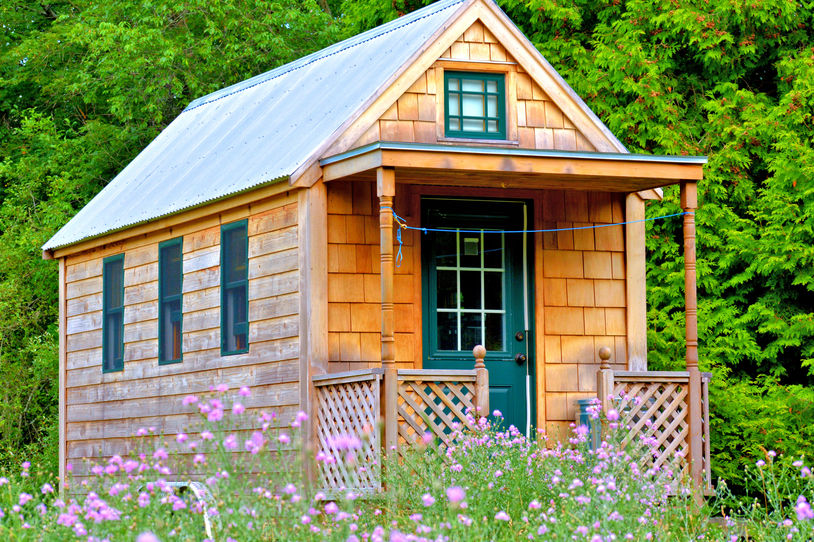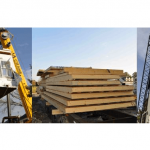Can Modular Construction Explode the Tiny Home Movement?


The Tiny Home Movement
The tiny house movement has swept the country. There are TV shows dedicated to it, blogs that rave about it, and people that are drawn to it to find a way to live more economically. Tiny homes are typically broken down into two types, mobile and permanent. Many of the shows on TV do a walk along with a couple that are looking to downsize and someone takes them to three different tiny homes on wheels to see which one they like the best. They are usually built on a tandem axle trailer frame and average 8’ wide by 16-20’ long. That means about 128 – 160 sq ft of living space.
The permanent tiny homes can be larger. Many definitions exist on how big a tiny home can be and still be tiny. The consensus seems to be that about 250 – 450 sq ft is the maximum size. That still isn’t much space to get living, bathing, and eating accomplished in one shelter. The limitation in size has sparked the creativity of many consumers and handymen alike to find unique ways to accomplish everything under one roof. The biggest limiting issue: tiny homes don’t meet any existing building or construction code.
Building Codes
 Homes built to live in across the country are subject to building codes (including all modular homes). In addition to how they are constructed, where they are constructed is subject to zoning laws in much of the country. Tiny homes have been struggling with both issues as their popularity has increased. There are several options for codes that a home/shelter/living space can fit into:
Homes built to live in across the country are subject to building codes (including all modular homes). In addition to how they are constructed, where they are constructed is subject to zoning laws in much of the country. Tiny homes have been struggling with both issues as their popularity has increased. There are several options for codes that a home/shelter/living space can fit into:
International Residential Code (IRC) – The IRC is the standard building code across the country which describes exactly how a home should be built (i.e. nailing patterns, roofing requirement, framing requirements, etc.). It also describes room sizes, ceiling heights, types of rooms, etc. This is where tiny homes go awry of the code and currently can’t meet IRC requirements.
Manufactured Home Code – A manufactured home is built to a Federal Building Code developed by the Dept. of Housing and Urban Development. It is known as the HUD code. It is a performance based code that says how a home must perform, not how it must be built. It is used to build manufactured homes (known by many as double-wides or mobile homes). Because of the size of the tiny home, it can’t use this code either.
Related: BUILD YOUR OWN TINY HOUSE AND MAXIMIZING YOUR BUDGET
Recreational Vehicles (RV) – The RV code (ANSI/NFPA 1192 Standard for Recreational Vehicles) is used to build RVs. However, RVs are not for permanent occupancy. They typically aren’t allowed to be parked in the backyard and lived in (although they can legally be parked in the backyard and stored forever).
Park Model RV – A Park Model is a unique trailer-type of RV that is designed to provide temporary accommodation for recreation or seasonal use. It is built on a chassis and cannot exceed 400 sq ft. It must be built in compliance with ANSI code A119.5. They can be up to 15 feet wide and 36 feet long. However, they are an RV and not meant for permanent occupancy.
In general, zoning laws limit residences to one per property in residential areas (there are areas with exceptions). When there are exceptions, all residential units on the property must meet building code for permanent residency. Most tiny homes today don’t meet any building code, or they meet an RV code that doesn’t allow for permanent occupancy or permanent attachment to the land. However, building codes change.
The 2018 International Residential Code
The development of the International Residential Code is a massive undertaking and takes place in three year cycles. Stakeholders from all walks of life and professions participate. This includes building inspectors, fire marshals, and other interested parties. Submissions have been made for review in the process to add a model code for Tiny Homes. It may or may not pass. It could be tabled for a future code iteration.
In any case, states adapt building code updates sporadically. If the Tiny House code update is adopted into the 2018 version of the IRC, it could take until 2021, 2024, or even 2027 until every state adopts the new code. Even if a state does adopt the new code, they can adopt it with deviations meaning they can exclude parts they don’t want. If Tiny Homes are included in the new code then the doors will open in many areas to their inclusion into communities.
Modular Construction
If Tiny Homes are included in an upcoming version of the code, modular construction is the perfect way to mass produce code compliant units. Think about the current method of production. Tiny homes are currently built in sheds and in back yards. There is no standard code so there are no inspections. Who knows how they are wired and how well they are built. Life/Safety issues can become a concern. How is waste disposed of or stored? Health issues can also be a concern. If tiny homes are included in a building code, they can then be inspected to that code. If that code classifies them as permanent living space per the IRC, then they can be included as primary residences and then start to be assimilated into zoning ordinances.
Modular construction is the perfect way to build tiny homes. Consumers would know that tiny homes were being designed and built to a defined building code. Inspections would take place in a factory to confirm that they met that code. The personal safety of the buyer and their family would be enhanced because standards would be adhered to by professional builders. The costs of tiny homes would come down considerably. The assembly line process of production in most modular factories would mean that homes could be produced at a consistent level of quality, and both quickly and cost-effectively.
Two Good Tastes that Go Great Together?
It seems that combining modular construction with tiny home production would be the perfect blend of two movements. Modular construction is green, energy efficient, less wasteful, and cost efficient. Tiny homes were born out of the wants of many to live green and cost efficiently.
Let’s see if 2018 brings Tiny Homes into the mainstream of construction where modular construction can propel them into the mainstream of America!
The post Can Modular Construction Explode the Tiny Home Movement? appeared first on Impresa Modular.




